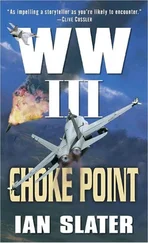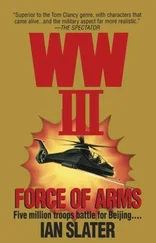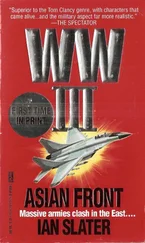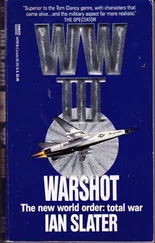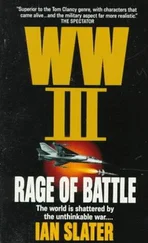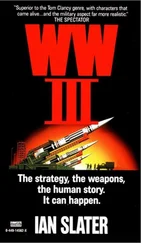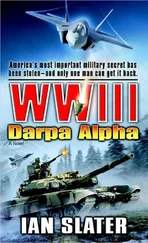“Slow to two knots,” ordered Freeman, Gomez’s hand already poised to do so in accordance with the detailed plan that all eight men had only recently committed to memory, so much so that each of the six-man hit squad was confident that should the storm obliterate any chance of moonlight, he could still make his way from Beach 5 up the stem of the Y-shaped trail then turn left, following the southern branch to the warehouse, which, running north to south, lay at the top of the Y between its two arms, the north-south Kosong-DMZ coastal road just fifty yards west of the warehouse. Indeed, Freeman had insisted they all go through the mock-up without the benefit of night-vision goggles. The unknown factor, of course — the latest SATPIX intel notwithstanding — was how heavily the warehouse was guarded. Would the NKA’s night watch be your regular flashlight, check-the-door walk-by, as you might expect if the NKA wasn’t expecting location-specific attack? Or had there been an intel leak on Freeman’s side, and now a full-blown NKA reception awaited them?
The sheets of rain drenching the fairly nondescript North Korean beach were both a “plus” and a “negative,” in Freeman’s words. The rain was so torrential, it would provide a veritable curtain between them and the beach during what the six-man hit squad, as well as Eddie Mervyn and Gomez, knew from personal combat experience would be the most vulnerable part of the mission. Exfil was tricky too, but you could always leapfrog each other’s position during withdrawal while your swim buddy laid down covering fire — if the enemy had detected your presence before you could get back to the craft.
The rain, of course, could be a negative factor going in, Freeman cautioned, adding that even the team’s thick-tread Vibram rubber soles could slip once rain-sodden earth and gravel filled the boots’ grip spaces.
For a moment Aussie was concerned that Bone Brady, preoccupied with loading his weapon, hadn’t heard the general.
“You asleep, black man?” he asked Brady in his typical upbeat, precastoff humor.
“Whatta you mean, milk face?” said Brody, palming in the chubby triangular box mag for his M-249 SAW, the hit squad’s automatic weapon, affectionately known by its operators as “Minimi.” “I ain’t been asleep, gringo.”
“Huh,” said Aussie. “Do you remember the general telling us how the Y track to this fucking shed has been covered in crushed gravel?”
“Yeah,” said Bone. “So?”
“So no slippin’ an’ slidin’ on the trail, big boy.”
“Well, y’know,” said Brady, “sometimes Charlie doesn’t stick to the trail. Sometimes he goes off trail and blindsides you when you’re all following the tourist path to and from the beach like good little Boy Scouts.”
“Point taken,” said Freeman. “Final weapons check.”
Each man gave him a thumbs-up, Sal’s raised so high and ramrod straight that Aussie told him yet once again how during his youth Down Under, such a gesture had been the equivalent of giving someone in America the finger.
“That’s the hundredth time you’ve told us that,” said Sal, his tone edgier than usual.
Everyone wanted to get out of the RS’s two hatches, whose “lids” were flush with the craft’s superstructure to decrease drag at high speed underwater. But now the RS was crawling toward the beach like some metallic slug, its electronic probes absorbing such a flood of incoming data that, like the driver of the latest computerized auto or the pilot of a brand-new Joint Strike Fighter, Eddie Mervyn and Gomez felt simply overwhelmed by the cascade of information. Right now, two hundred yards from the surf, the RS’s computers were giving myriad readouts of wind speed, outside temperature, inside temperature, fuel remaining, electric motor range using MUSCLES system only, jet-pulse range, humidity both inside and outside the RS, and the sea’s salinity content, the computers accordingly making the necessary algorithmic corrections for possible torpedo or decoy firing. Ballast tanks’ status, circuitry verifications, and aerial and hydrophone arrays status were also being integrated to calculate the course of least resistance amid the myriad crosscurrents and rips of the surf. Most of the displayed data was being ignored by the RS’s pilot and copilot, except for four readouts: the precise distance to beach, the angle of beach incline, the water’s decreasing depth, and the graph line showing the exact point at which the RS would become visible. When they reached that point, Eddie Mervyn, with Gomez double-checking, would lift the hard black plastic safety guard over the zebra-striped button that would deploy the RS’s tractorlike treads. Like the wheels of a light aircraft suddenly descending from their previously fuselage-covered wells, the RS’s two forward and two rear miniature oval caterpillar tracks would allow the RS to keep moving forward without pause , taking the team beyond the surf surge, allowing the hit team to deploy dry and so not be weighed down by sodden combat pack or no-name fatigues.
Sal tore open a Trojan packet, took out the condom, and stretched it over the end of his shotgun’s barrel. The reversible-submersible was designed to take them in very close, from the sea’s continental slope or littoral into shallows no deeper than three feet, but Sal’s motto for such amphibious landings had been taken from a sign he’d read as a young boy on holiday in Maui: “All Waves Are Dangerous.” He’d seen more than one SEAL accidentally “baptized by full immersion,” as the instructors called it, the SEAL at the point of disembarkation necessarily turning his back to the sea, loaded with full combat pack one second, underwater the next, felled by a wave that normally wouldn’t have challenged a ten-year-old.
On the infrared search scope’s flat screen they could see the phosphorescent dancing of surf and rain, the rushes of foam going farther than usual across the sand of Beach 5 because of the gale-force winds. Immediately beyond the undulating line that marked the dip and rise of sand dunes was another line. This varied in height from 50 to 130 feet, delineating the jagged crest of steep, scrub-covered cliffs. The latent heat of the land, relative to the colder sea, was emitting tendrils of mist that spiraled up here and there, resembling the vapor columns from hot springs, of the kind SATPIX intel had revealed in the Nine Moon Mountains southwest of Pyongyang.
“Tracks deployed,” announced Eddie Mervyn, the small Kit-Kat-sized SOC — status-of-craft screen — informing them that they were now 138 yards from the lacy foam of exhausted surf. The SOC’s data block also informed them that in precisely one minute and forty seconds, the top of the teardrop bow would be visible to “EXT VWS”—external viewers — at a point between two of the big X-shaped beach defenses, meant to be an impediment to the big American Wasp-class LHDS’—Landing Helicopter Dock Ships’—landing craft.
“Hope any external viewers are in bed,” said Aussie.
No one answered him. Mervyn checked the data block again and announced, “Hatches opening in two minutes. I say again, lids opening in two minutes.”
“Hatches opening in two minutes,” acknowledged the general, adding, “Aussie, you and Choir follow me through hatch one. Sal, you lead Bone and Johnny through two. Confirm.”
Aussie and Choir gave a thumbs-up, answering in unison, “Follow you through hatch one.”
“Good,” said Freeman, upon which Sal, Bone Brady, and Johnny Lee answered, not in unison but in staggered response, “Hatch two.”
“Very good,” said Freeman. They’d rehearsed this confirmation drill at least a dozen times en route to McCain , but dammit, neither Sal, Bone, nor Lee had been able to answer in unison, each of them slightly out of sync with the other two. All right, thought Freeman, he’d say nothing about it. First, it would sound tendentious in the extreme, like a frantically obsessive schoolteacher he once had in high school who had routinely gone ballistic if you didn’t recite a sonnet error-free. “No, no, no, no, NO !” the general remembered her chastising her students, and then abruptly brought himself back to the present.
Читать дальше

